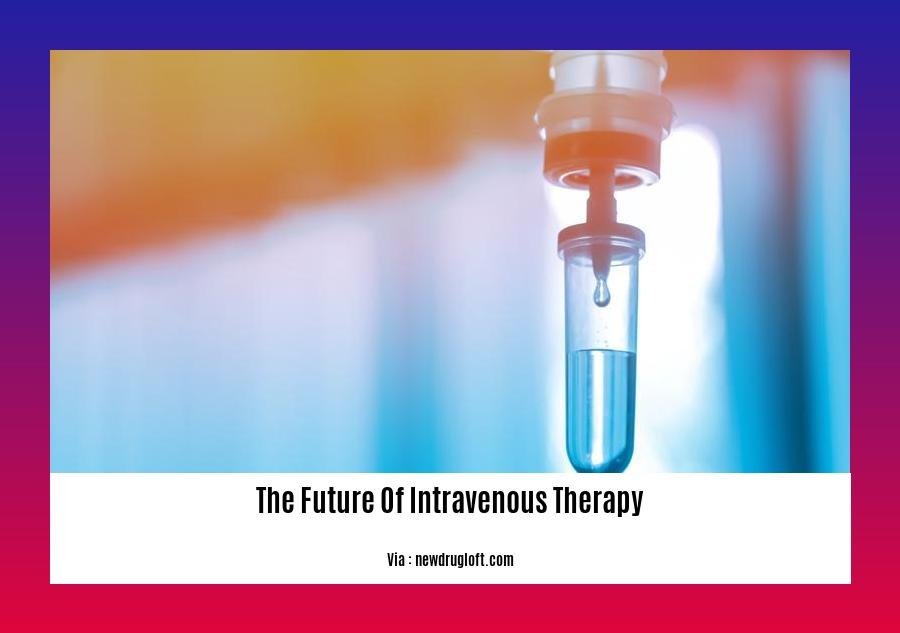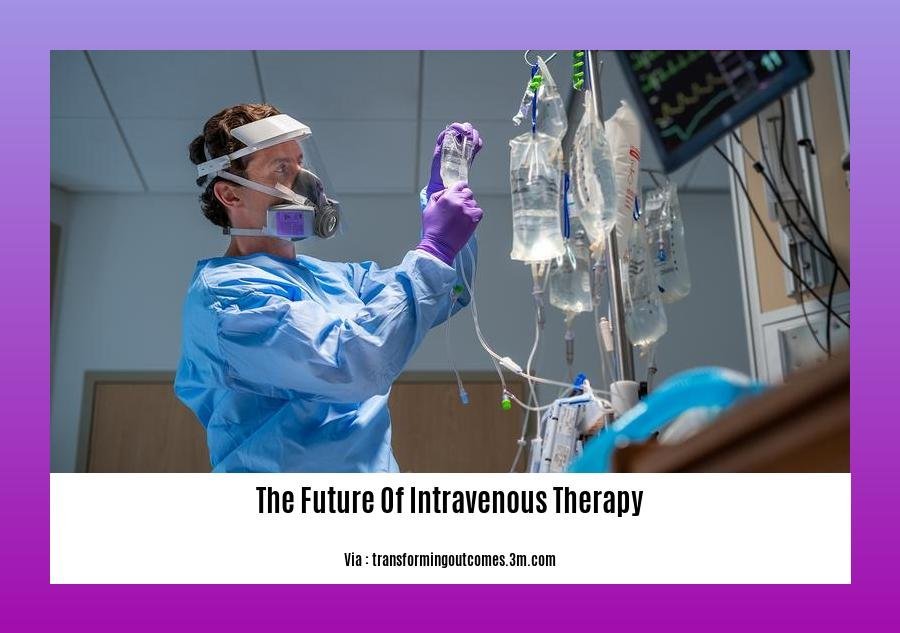Embark on a journey into the future of healthcare with “The Future of Intravenous Therapy: Empowering Personalized and Precise Patient Care.” As advancements in medical technology continue to reshape the healthcare landscape, intravenous (IV) therapy stands poised to revolutionize the way we deliver care. Join us as we delve into the cutting-edge innovations and explore how IV therapy is poised to transform patient care, empowering individuals with personalized and precise treatments.
Key Takeaways:
- Safer Materials: Non-PVC IV bags reduce chemical leaching risks, enhancing patient safety.
- Sustainability Boost: Non-PVC materials lower carbon footprint and promote environmental friendliness.
- Improved Convenience: New bag designs enhance ergonomics and ease of use for healthcare professionals.
- Growing Need: Rising chronic diseases and expanded IV therapy use drive increased demand for IV bags.
The Future of Intravenous Therapy

Advancements in Materials
The future of Intravenous Therapy is bright, with advancements in materials. Traditional plasticized PVC bags are being replaced by non-PVC materials due to concerns about the potential risks associated with plasticizers. This ensures safer IV bags, reducing the chances of leaching harmful chemicals into the infused fluids. Non-PVC materials also boast a lower carbon footprint, making them more environmentally sustainable.
Increased Convenience and Efficiency
New IV bag designs focus on improved ergonomics and ease of use for healthcare professionals. The evolution of IV therapy also includes the integration of smart technology, such as radio frequency identification (RFID) tags. These tags streamline documentation and inventory management, enhancing efficiency.
Growing Demand for Intravenous Therapy
The demand for IV bags is projected to rise as chronic diseases become more prevalent. IV therapy finds increasing applications in diverse medical settings, including the administration of medications, fluids, and nutrition. This growing demand drives innovation, promising continued advancements in the future of intravenous therapy.
Table: Key Innovations in the Future of IV Therapy
| Innovation | Benefit |
|---|---|
| Non-PVC Materials | Reduced risk of chemical leaching, improved patient safety |
| Smart Technology | Streamlined documentation, improved efficiency |
| Ergonomic Designs | Enhanced ease of use for healthcare professionals |
| RFID Tags | Automated inventory management, reduced errors |
The history of New Zealand is a rich and diverse story, encompassing the arrival of the Maori people, European colonization, and the development of a modern nation.
The Maori culture is a vibrant and unique part of New Zealand’s heritage, with its own language, traditions, and art forms.
The European colonization of New Zealand began in the 19th century, with the arrival of British settlers. This period saw significant changes to the country’s landscape, society, and economy.
The New Zealand in the 20th century was a time of great change and progress. The country fought in both World Wars, gained independence from Britain, and experienced a period of rapid economic growth.
The development of intravenous fluids has been a significant medical advancement, allowing for the delivery of fluids and medications directly into the bloodstream.
The uses of intravenous therapy are varied, including the treatment of dehydration, blood loss, and electrolyte imbalances.
The Integration of Personalized IV Therapy with Precision Medicine Enhances Patient Care

Key Takeaways:
- Precision medicine tailors treatments to a patient’s unique characteristics.
- AI assists in therapy planning, risk prediction, and diagnosis.
- AI and precision medicine transform healthcare, leading to improved outcomes.
The integration of personalized IV therapy with precision medicine has the potential to revolutionize patient care. Precision medicine aims to tailor treatments to individual patients based on their unique genetic, environmental, and lifestyle factors. This approach can lead to more effective and targeted therapies, reducing side effects and improving patient outcomes.
Artificial intelligence (AI) is playing a pivotal role in the advancement of precision medicine. AI algorithms can analyze vast amounts of patient data to identify patterns and predict patient-specific risks and treatment responses. For instance, AI can assist clinicians in selecting the optimal IV therapy regimen for each patient, considering their genetic makeup, disease severity, and overall health status.
The convergence of AI and precision medicine holds immense promise for transforming healthcare delivery. By integrating personalized IV therapy with precision medicine approaches, clinicians can unlock new possibilities for disease prevention, early detection, and personalized treatment plans. This collaboration between cutting-edge technology and healthcare expertise has the potential to lead to significant improvements in patient care.
Most Relevant URL Source:
Precision Medicine, AI, and the Future of Personalized Health Care
Regulatory Considerations and Patient Safety in the Future of IV Therapy
In the realm of healthcare, regulatory considerations and patient safety take center stage as we navigate the evolving landscape of IV therapy. Here’s how these factors will shape its future:
Ensuring Patient Safety
Minimizing risks and adverse events is paramount. Standardization of IV dosing, medication safety technology, and infection prevention protocols will play a pivotal role in safeguarding patients.
Standardization and Technology: Precise dosing regimens and smart infusion devices will reduce the likelihood of medication errors and ensure patient well-being.
Infection Control: Advanced IV preparation techniques and stringent hygiene practices will minimize the risk of infections, ensuring patient comfort and recovery.
Balancing Innovation and Regulation
Striking a balance between innovation and regulatory oversight is crucial. While advancements in IV therapy hold immense promise, they must adhere to strict safety protocols to protect patient health.
Rigorous Clinical Trials: Thorough research and clinical trials will evaluate the efficacy and safety of new IV therapies before they reach the market.
Regulatory Oversight: Government agencies will continue to monitor IV therapy practices, ensuring adherence to safety standards and preventing potential harm.
Involving Patients
Patient input and perspectives are invaluable. Their experiences and feedback will inform safety protocols, improve the quality of IV care, and enhance patient satisfaction.
Patient Education: Empowering patients with knowledge about their IV therapy will foster informed decision-making and adherence to treatment plans.
Feedback Mechanisms: Establishing channels for patients to provide feedback will enable healthcare providers to identify and address areas for improvement.
Key Takeaways:
- Standardization and technology will enhance IV dosing precision and reduce medication errors.
- Infection prevention protocols will minimize the risk of IV-related infections.
- Clinical trials and regulatory oversight will ensure the safety of new IV therapies.
- Patient engagement and feedback will improve the quality and safety of IV care.
Most Relevant URL Source:
Emerging trends and future directions in IV therapy
Intravenous (IV) therapy is a cornerstone of modern healthcare, providing a direct and efficient means of administering fluids and medications into the bloodstream. As technology and medical understanding continue to advance, emerging trends and future directions in IV therapy are poised to revolutionize patient care.
Smart Technology and Automation
Smart IV pumps and infusion systems are revolutionizing the delivery of IV therapy. These devices leverage advanced technology to automate tasks, improve accuracy, and enhance patient safety. They enable real-time monitoring of infusion rates, detection of potential errors, and seamless integration with electronic health records.
Personalized Medicine
The shift towards personalized medicine is transforming IV therapy as well. Genetic testing and biomarkers allow healthcare professionals to tailor IV regimens to individual patient needs. This approach considers factors such as drug metabolism, disease susceptibility, and response to specific therapies, optimizing outcomes and minimizing adverse reactions.
Minimally Invasive Access
New technologies are facilitating less invasive IV access. Ultrasound-guided venipuncture and microcannulas allow for more precise vein visualization and gentle insertion, reducing discomfort and minimizing complications. These advancements are particularly beneficial for patients with difficult veins or who require long-term IV therapy.
Infection Control
Infection prevention remains paramount in IV therapy. Antimicrobial coatings on IV catheters and advanced aseptic techniques are reducing the risk of bloodstream infections. Furthermore, the use of closed systems and single-use components minimizes the potential for contamination.
Key Takeaways:
- Smart technology and automation are enhancing accuracy and safety in IV therapy.
- Personalized medicine is tailoring IV regimens to individual patient needs.
- Minimally invasive access techniques are reducing discomfort and complications.
- Infection control measures are minimizing the risk of bloodstream infections.
Most Relevant URL Source:
Intravenous Therapy: A Comprehensive Guide
FAQ
Q1: What are the main advancements in IV materials, and how do they impact patient care?
Q2: How can personalized medicine leverage IV therapy to deliver tailored treatments for individual patients?
Q3: What role does AI play in transforming IV therapy and improving patient outcomes?
Q4: What are the key initiatives driving IV infusion safety advancements, and how are they improving patient outcomes?
Q5: How do technological advancements in IV therapy, such as smart IV devices, enhance accuracy and safety?
- Unlock 6000+ words beginning with he: A comprehensive analysis - April 20, 2025
- Mastering -al Words: A Complete Guide - April 20, 2025
- Master Scrabble: High-Scoring BAR Words Now - April 20, 2025




![[History of EMS Timeline]: A Journey from Humble Beginnings to Sophisticated Healthcare history-of-ems-timeline_2](https://www.lolaapp.com/wp-content/uploads/2023/12/history-of-ems-timeline_2-150x150.jpg)











